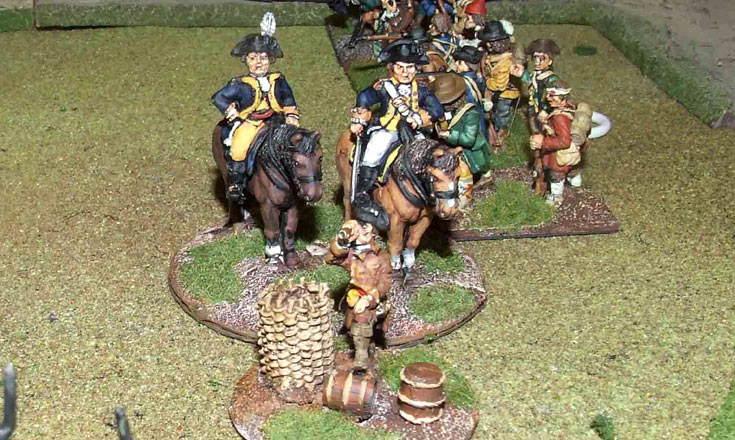
The Battle of Hubbarton, 1777
20th February 2008, Comments Off
The American War of Independence, British Grenadier, 28mm
Well, Dave Imrie has been painting up more of his American War of Independence figures (that’s the “American Revolution” to you Colonials), and he wanted a game. Given the lead at our disposal we decided to try out the Hubbarton scenario in the latest British Grenadier Scenario Book – only we scaled it to a 1 figure = 15 men re ratio. The idea is that the Americans had to save their guns, while the rest of their small army tried their best to repel a surprise British attack. Well, I forgot most of my guns and all my limbers, so the train was reduced to just two models – something that eventually worked in the Americans’ favour.
The idea is that the Americans had to save their guns, while the rest of their small army tried their best to repel a surprise British attack. Well, I forgot most of my guns and all my limbers, so the train was reduced to just two models – something that eventually worked in the Americans’ favour. The scenario starts with the British advanced guard launching a surprise attack on the Americans – who take a turn to wake up and sort themselves out. Dave Imrie (commanding the British) decided to launch his grenadiers in an all-out attack supported by his light troops, while the rest of his force tried to cut off the escape route for the American guns. Well, the Grenadiers were stopped cold by American musketry, and when they reached 50% strength they failed their dispersal test. So far so good. then it all started to unravel.
The scenario starts with the British advanced guard launching a surprise attack on the Americans – who take a turn to wake up and sort themselves out. Dave Imrie (commanding the British) decided to launch his grenadiers in an all-out attack supported by his light troops, while the rest of his force tried to cut off the escape route for the American guns. Well, the Grenadiers were stopped cold by American musketry, and when they reached 50% strength they failed their dispersal test. So far so good. then it all started to unravel. My brigade of two poor quality American regiments conducted a fighting retreat, covering the guns. However my co-commander Dave O’Brien sent one unit to cover the guns, and the other actually advanced on the British reserves when they came on. It was plucky, but very foolhardy – the American unit was rated as “2nd Class Line”, while the British were Elite! Amazingly they pushed the British back on the first turn, only to collapse the following turn. Across the table the Americans who should have been protecting the guns routed before the charging British unit even came into contact! In one turn the rebel general O’Brien lost his entire command…
My brigade of two poor quality American regiments conducted a fighting retreat, covering the guns. However my co-commander Dave O’Brien sent one unit to cover the guns, and the other actually advanced on the British reserves when they came on. It was plucky, but very foolhardy – the American unit was rated as “2nd Class Line”, while the British were Elite! Amazingly they pushed the British back on the first turn, only to collapse the following turn. Across the table the Americans who should have been protecting the guns routed before the charging British unit even came into contact! In one turn the rebel general O’Brien lost his entire command… Fortunately I’d just managed to roll the guns off the table – if the artillery train had been any bigger it would have been captured. Technically we’d won the scenario, but only by being very “gamey”! The British then proceeded to demolish the remaining American units, routing the third of the four units of American line, and sending the last one scuttling back towards the table edge. While we American players claimed a “technical” victory, we were in no doubt about who really won!
Fortunately I’d just managed to roll the guns off the table – if the artillery train had been any bigger it would have been captured. Technically we’d won the scenario, but only by being very “gamey”! The British then proceeded to demolish the remaining American units, routing the third of the four units of American line, and sending the last one scuttling back towards the table edge. While we American players claimed a “technical” victory, we were in no doubt about who really won! The rules we used were British Grenadier, which worked a treat. This was the first time we’d played them properly, with the disruption points system (which in turn was looted from Andy Callan’s excellent Loose Files and Scramble). It really worked well, and penalised the poorer quality units without getting in the way of the game flow. We all thoroughly enjoyed ourselves, and are eager to revisit the period very soon.
The rules we used were British Grenadier, which worked a treat. This was the first time we’d played them properly, with the disruption points system (which in turn was looted from Andy Callan’s excellent Loose Files and Scramble). It really worked well, and penalised the poorer quality units without getting in the way of the game flow. We all thoroughly enjoyed ourselves, and are eager to revisit the period very soon.

